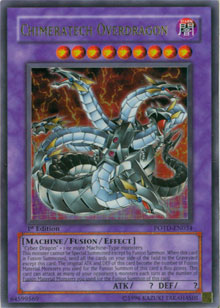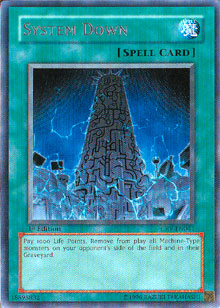 As SJC Orlando wrapped up, internet
As SJC Orlando wrapped up, internet
forums for Yu-Gi-Oh! TCG discussion were blazing with debate. The sight of four Chimeratech combo decks had players wondering what exactly happened at the tournament. Many people were questioning the power level of Chimeratech Overdragon, and even pondered whether or not the card is healthy for the advanced format.
Note that all of this discussion was taking place within twenty-four hours of the Top 8 decklists being posted here at Metagame.com. That’s a lot of speculation within such a short timeframe. In case you missed it, you should check out the coverage. There were high expectations for this tournament since it was the premiere event of the new Gadget monsters. If you haven’t picked up a copy (or three) of Machine Re-Volt, then you should consider doing so. Aside from the insane little Machine monsters found in the deck, Machine Re-Volt also has some common variants of Enemy Controller and Sakuretsu Armor, and if you’re a real cheapskate like me, then you’ll probably need a couple of easy-to-get copies of Enemy Controller.
Going into the event, many players were wondering how Gadgets would fare here in North America. Some players considered combining the Gadgets with Chimeratech Overdragon in order to utilize the powerful engine of little Machine monsters before playing a game-ending Overload Fusion. Others wanted the game win condition to be the Ultimate Offering combo, which essentially allows you to summon an entire field’s worth of Red Gadgets, Yellow Gadgets, and Green Gadgets in one turn for an all-out rush.
Most of the decks, however, retained the Gadgets’ original look. Most players have kept Gadgets as a control strategy, where the Gadgets provide the raw win condition (damage) and their controller uses cards such as Sakuretsu Armor and Smashing Ground to whittle down resistance. The deck also runs Solemn Judgment cards to deal with non-monster threats that may throw a monkey wrench into the Gadget deck (such as Royal Decree and Deck Devastation Virus).
Players have also run either Snipe Hunter, Chiron the Mage, or both as another way to deal with frustrating continuous spells and traps along the lines of Royal Decree. Snipe Hunter also makes use of extra Gadgets a player may have drawn throughout the game that will no longer fetch another Gadget from his or her deck. In this case, those extra Gadgets can allow Snipe Hunter to blow up troublesome cards on the opponent’s field, or it can allow you to push through the opponent’s defenses for a quick win.
This has led to some very powerful control variants on the Gadget theme. However, no matter what you do with the Gadgets, they’re almost always going to involve winning via battle. In fact, the entire deck is based on blowing away face-up monsters (along with monsters that attack you), and then returning the attacks with an army of Machines. Gadgets will typically have a tougher time dealing with face-down monsters. Some players who went to SJC Orlando knew this, and built decks ready to combat one of the current weaknesses to the Gadget control deck.
One group aimed at directly countering Gadgets was Team Rampage. You may have read about them in the SJC Orlando coverage, or perhaps noticed that they placed three people in the Top 8 of that tournament with their bare-bones Chimeratech combo strategy. While Chimeratech Overdragon has been known as a power card since its release, the big fusion really hadn’t been given a chance to shine. However, the format was just right for this deck to make its big debut. Reactive monsters such as UFO Turtle and Dekoichi the Battlechanted Locomotive become very powerful when they’re filtering through the Chimeratech player’s deck while filling up the graveyard with Machines. The best part about this is that Gadgets can rarely do anything about a face-down recruiter or Dekoichi that isn’t wince-worthy at the time of execution.
The result is that the Gadget’s major weaknesses help guarantee that the Chimeratech player fills up the graveyard and finds its combo pieces. But that’s not all. Gadget is also about always summoning your monsters. You will rarely set a monster face down when playing Gadgets, and this is the ultimate weakness Gadgets have against Chimeratech. Not only will their constant attacks into face-down monsters fuel the combo, but when one of the players from Team Rampage sets up his Overload Fusion to summon out Chimeratech Overdragon when the opponent’s spell and trap zone is blown away or nullified (either by Giant Trunade or Jinzo), the new Dark fusion will have a ton of little Machine monsters to crash its five-digit ATK value into!
 The greatest part about the success of both of these decks is that it’s a huge encouragement for many players to run Machines. In fact, that’s what this tournament is really screaming to everyone. Machine monsters are awesome. Players know Machine monsters are awesome. And that leads to making an old spell card one of the coolest side-deck tech options I’ve seen in ages: System Down.
The greatest part about the success of both of these decks is that it’s a huge encouragement for many players to run Machines. In fact, that’s what this tournament is really screaming to everyone. Machine monsters are awesome. Players know Machine monsters are awesome. And that leads to making an old spell card one of the coolest side-deck tech options I’ve seen in ages: System Down.
Mark Vasquez and Chris Evans both packed two copies of System Down in their side decks at SJC Orlando. For Mark, it was an ability to give his Monarch Control deck an extra edge against Gadget control. Not only would Mark have the ability to summon powerhouses like Thestalos the Firestorm Monarch, but he’d also have the ability to essentially play Raigeki against Gadget decks. That’s pretty much what System Down is, after all. Against certain decks, it’s actually more than a Raigeki. For 1000 life points, you get a Raigeki and a successful Fiend Comedian for a specific type of monster, all rolled into one. Mark can look at his Gadget opponent and say, “That’s a nice field you’ve built up. Please remove it from play. Oh, and by the way, your Pot of Avarice or Overload Fusion are pretty bad right now.”
Chris Evans had a similar idea. However, Chris’s hope was to use System Down as a way to give him a major edge in the expected mirror match. This is definitely a great example of making powerful use of the side deck, since Chris is using it to strengthen what he expects to be his most common matchups.
What’s nice about System Down is that it has some uses against Chimeratech as well. Being able to nullify a Chimeratech deck’s graveyard with one card can be a powerful tool for preventing Chimeratech Overdragon from coming down and demolishing you. While you are still vulnerable to the Dimension Fusion portion of the deck, you can always use your opponent’s Dimension Fusion to your own benefit with cards that would remove some of your bigger monsters from your graveyard.
Like Team Rampage’s deck choice for SJC Orlando, System Down is a great example of a card that has its uses at the right time. While Chimeratech may thrive best in a Gadget-oriented format, System Down thrives in a format filled with tons of Machine monsters. With the release of the Gadgets and the SJC win by Paul Lyn’s Chimeratech variant, there’s a very good chance you’ll be seeing plenty of Machines on your opponent’s side of the field and in his or her graveyard. If that’s the case, make sure you keep System Down open as a option to include in your side deck. It could be a very powerful silver bullet for you in a future tournament.